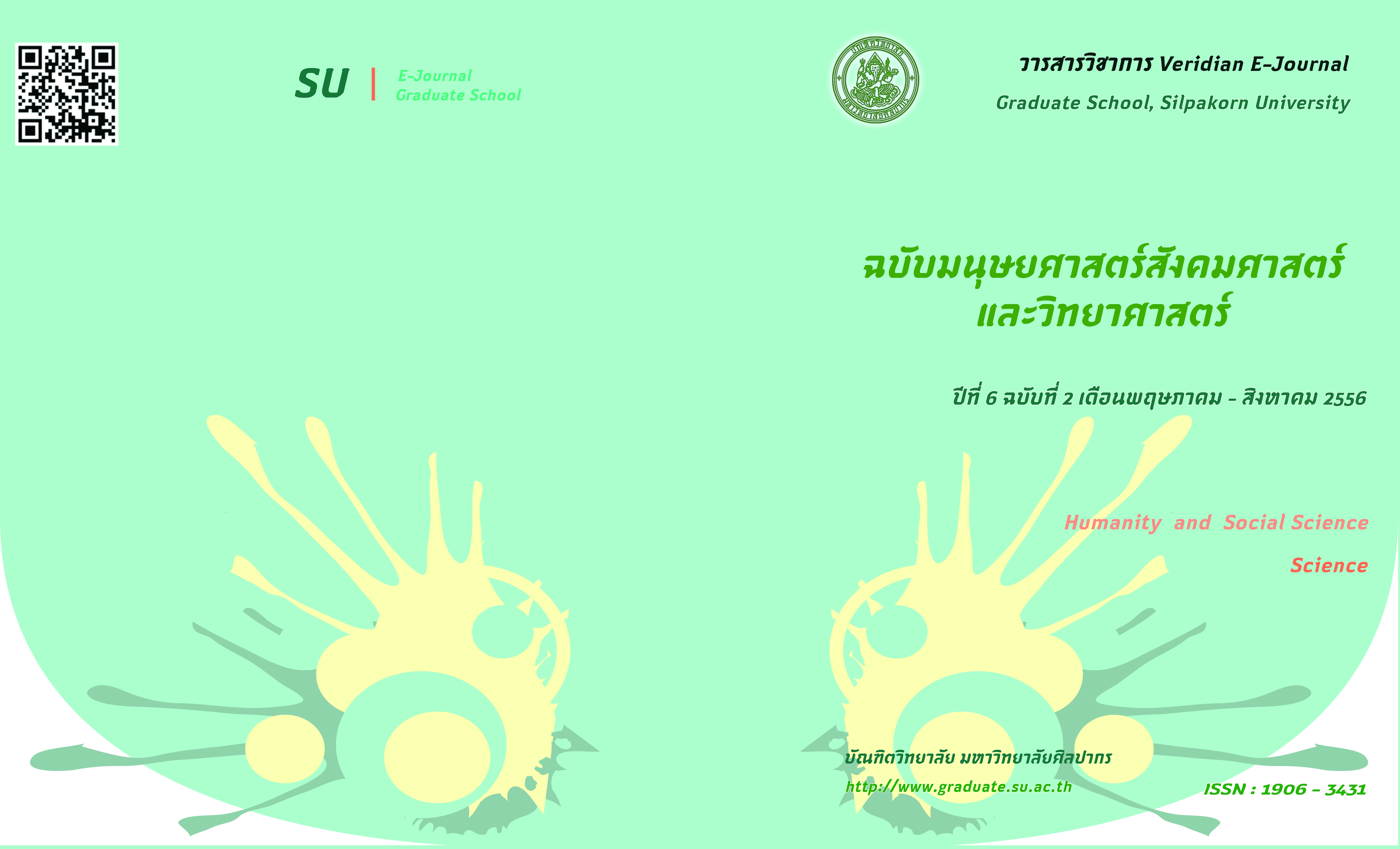ผลการเรียนแบบผสมผสานด้วยวิธีการสอนแบบสาธิตเพื่อการฝึกทักษะปฏิบัติวิชาคอมพิวเตอร์กราฟิก เรื่องการสร้างภาพเคลื่อนไหว ของนักเรียนชั้นมัธยมศึกษาปีที่ 3 โรงเรียนสิรินธรราชวิทยาลัย
Main Article Content
บทคัดย่อ
บทคัดย่อ
การวิจัยนี้มีวัตถุประสงค์ 1) เพื่อเปรียบเทียบผลสัมฤทธิ์ทางการเรียนก่อนและหลังเรียน โดยการจัดการเรียนแบบผสมผสานด้วยวิธีการสอนแบบสาธิต เพื่อการฝึกทักษะปฏิบัติ เรื่องการสร้างภาพเคลื่อนไหว วิชาคอมพิวเตอร์กราฟิก 2) เพื่อศึกษาผลของการปฏิบัติงานการสร้างภาพเคลื่อนไหว โดยการจัดการเรียนแบบผสมผสาน ด้วยวิธีการสอนแบบสาธิต เพื่อการฝึกทักษะปฏิบัติ เรื่องการสร้างภาพเคลื่อนไหว วิชาคอมพิวเตอร์กราฟิก 3) เพื่อศึกษาความพึงพอใจของนักเรียน ต่อการเรียน โดยการจัดการเรียนแบบผสมผสาน ด้วยวิธีการสอนแบบสาธิต เพื่อการฝึกทักษะปฏิบัติ เรื่องการสร้างภาพเคลื่อนไหว วิชาคอมพิวเตอร์กราฟิก กลุ่มตัวอย่างเป็นนักเรียนระดับชั้นมัธยมศึกษาปีที่ 3 ที่ได้มาโดยวิธีการสุ่มแบบยกชั้น ( Cluster Random Sampling) จำนวนทั้งสิ้น 40 คน
เครื่องมือที่ใช้ในการวิจัย ได้แก่ 1) แผนการสอนการจัดกิจกรรมการเรียนแบบผสมผสาน 2) ระบบบริหารการเรียนรู้ (LMS) 3) แบบวัดผลสัมฤทธิ์ทางการเรียน 4)แบบประเมินผลของการปฏิบัติงาน และ 5) แบบสอบถามความพึงพอใจ การจัดการเรียนแบบผสมผสาน ด้วยวิธีการสอนแบบสาธิต เพื่อการฝึกทักษะปฏิบัติ เรื่องการสร้างภาพเคลื่อนไหว วิชาคอมพิวเตอร์กราฟิก
ผลการวิจัยพบว่าผลสัมฤทธิ์ทางการเรียนของนักเรียนโดยการจัดการเรียนแบบผสมผสานด้วยวิธีการสอนแบบสาธิต เพื่อการฝึกทักษะปฏิบัติ เรื่องการสร้างภาพเคลื่อนไหว วิชาคอมพิวเตอร์กราฟิก มีคะแนนผลสัมฤทธิ์หลังเรียนสูงกว่าก่อนเรียนอย่างมีนัยสำคัญทางสถิติที่ระดับ .01 โดยที่ผลของ การปฏิบัติงานการสร้างภาพเคลื่อนไหว โดยการจัดการเรียนแบบผสมผสาน ด้วยวิธีการสอนแบบสาธิต เพื่อการฝึกทักษะปฏิบัติ คะแนนผลของการปฏิบัติงานคิดเป็นร้อยละ 82.33 และความพึงพอใจของนักเรียน โดยการจัดการเรียนแบบผสมผสาน ด้วยวิธีการสอนแบบสาธิต เพื่อการฝึกทักษะ เรื่องการสร้างภาพเคลื่อนไหว วิชาคอมพิวเตอร์กราฟิกมีระดับความพึงพอใจมากที่สุด ( = 4.54 ,S.D. = 0.22 )
Abstract
The purpose of this research were 1) to compare the pretest and posttest achievement score on the blended learning with demonstration technique for practice training on building animation of computer graphic , 2) To study the effects of performance on building animation that learned the blended learning with demonstration technique for practice training on building animation of computer graphic 3) To study the students’ satisfaction toward that learned the blended learning with demonstration technique for practice training on building animation of computer graphic . the. sample were 40 students from Matthayomsuksa 3 selected by area of cluster random sampling.
The instruments consisted of 1) lesson plans and learning activities on the blended learning with demonstration technique for practice training on building animation of computer graphic subject, 2) learning management system. 3) an achievement test of pretest and posttest, 4) evaluation of performance, 5) the satisfaction questionnaire toward that learned the blended learning with demonstration technique for practice training on building animation of computer graphic subject.
The results of the research found that : 1) The posttest achievement scores of students by using the blended learning with demonstration technique for practice training on building animation of computer graphic subject were higher than the pretest achievement scores at the statistical level at .01 significant difference. 2) The result of performance on building animation by using the blended learning with demonstration technique for practice training was 82.33 percent. 3) The students had the highest level of satisfaction by using the blended learning with demonstration technique for practice training on building animation of computer graphic subject. ( = 4.54 , s.d. = 0.22 )

